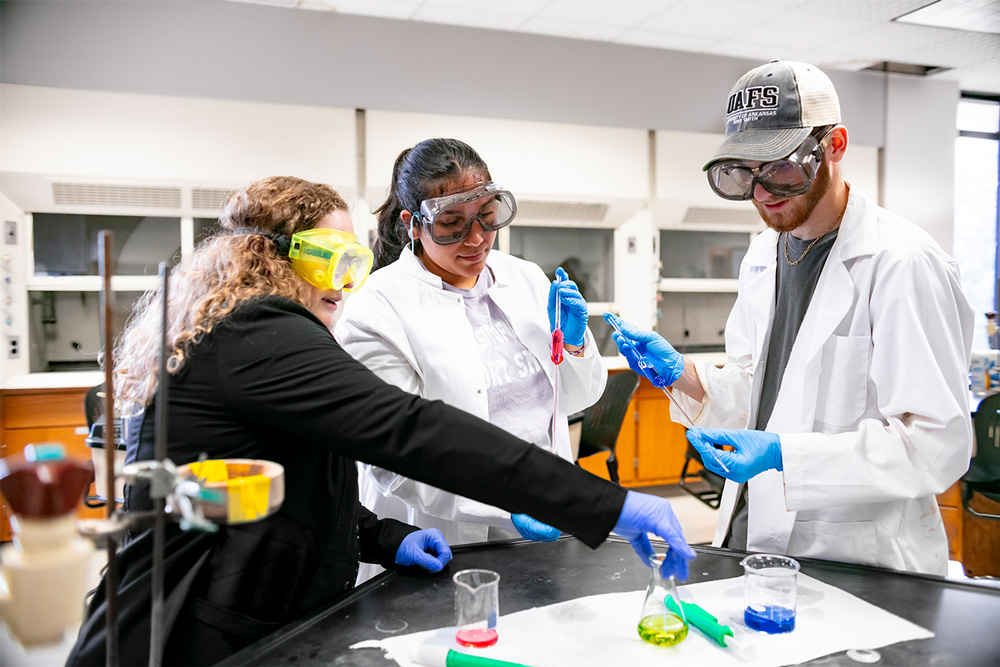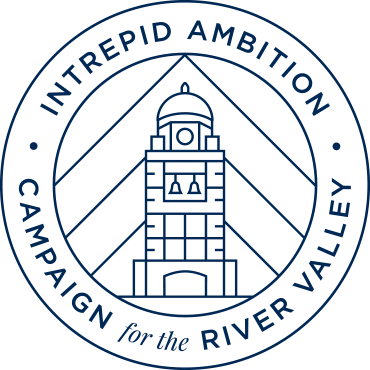
Associate Professor of Chemistry, Dr. Jordan Mader (left), works with students in her lab
Preserving Our Future
Written By: Rachel Putman
“Microplastics are everywhere,” says Dr. Jordan Mader, Associate Professor of Chemistry. “In food, water, and air; in the clouds above us, trapped in ice on glaciers, and in fat and muscle tissues.”
That includes right here in Arkansas. UAFS scientists have found microplastics in the Arkansas River — a vital resource for the region’s agriculture, transportation, and recreation. But just how contaminated is the river? That’s the question Mader and Dr. Maurice Testa, Associate Professor of Geoscience, set out to answer in 2019.
They quickly realized that microplastics present a unique challenge. Unlike other pollutants, “there was no scientifically agreed-upon standard for clumping microplastics together so they could be counted,” says Mader. “If we wanted to measure the number of microplastics in the Arkansas River, we were going to have to build that foundation ourselves.”
Three years later, UAFS is leading microplastic research, thanks to Mader and Testa’s work. Supported by teams of undergraduate students, they are refining a method using a surfactant to cluster microplastics together—an approach that has the potential to transform environmental monitoring and policy, starting with the river that runs through our own backyard.
“The projects that students are pursuing at UAFS in Physical Sciences not only have a direct impact on their student experience and their journey post-graduation,” says Mader, “but they also allow for a chance to improve the quality of the environment in the River Valley, across Arkansas as a whole, and may lead to a publication in the scientific literature that allows scholars and researchers across the world to benefit from their work.”
“This was the first time anyone had ever done this,” explains Testa, describing the research he and Mader undertook with their students to develop a method for quantifying microplastics in the water supply. It’s groundbreaking work—led not in sprawling graduate labs but by undergraduates at UAFS.
Unlike larger institutions, where students may not engage in meaningful research until graduate school, UAFS offers hands-on research opportunities from the moment students arrive on campus. More than two dozen undergraduates have worked alongside Mader and Testa, presenting at national conferences, authoring research papers, and contributing to environmental science before even earning their degrees.
This direct collaboration with faculty doesn’t just bolster resumes—it cultivates a deep sense of purpose. The expansion of faculty research opportunities means even more students will gain exposure to scientific inquiry that prepares them for competitive graduate programs and careers in STEM fields.
“Our students are getting an almost graduate-level experience,” says Mader, who is also the inaugural Faculty Fellow for the Center for Teaching and Learning, speaking to the long-term impacts on student engagement. “Undergraduate research is a gateway to deeper learning, fostering critical thinking, problem-solving, and creativity. It empowers students to move beyond textbooks and engage in the process of discovery, transforming them from passive learners to active contributors to knowledge.” Students learn essential skills—critical reading, technical writing, collaboration, and public presentation—that extend far beyond the lab. “They are very successful in their regular classes,” Testa adds, “and they develop close ties with their UAFS community.” The impact, he says, is profound. “Many of the students involved in research leave the lab as completely different people. They do a 180.”
One of those students is Emily Blitz, ‘21, now in medical school at the University of Arkansas for Medical Sciences. “We all played a role in the microplastics research—students and professors—reading, writing, designing, and implementing,” she says.
"When you are in the lab with professors, it’s more than a mentorship. You develop a relationship where you learn to trust their critiques because you know you are going to get all the support you need to succeed,” she said.
UAFS students and faculty are driving scientific breakthroughs with urgency and focus. In the fight against microplastic pollution, they’re not waiting for answers—they’re creating them. They’re transforming curiosity into world-class research with the potential to change policy, protect ecosystems, and elevate Arkansas as a leader in environmental science. That’s the power of Intrepid Ambition.
Learn more at uafs.edu/intrepid-ambition.

This story is powered by Intrepid Ambition – the vision to dream and the courage to lead.
Rachel Rodemann Putman
- Director of Strategic Communications
- 479-788-7132
- rachel.putman@uafs.edu
